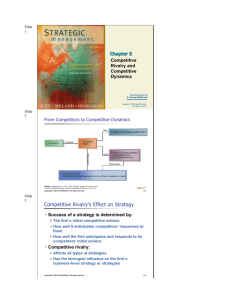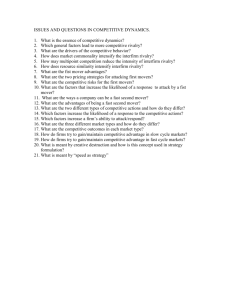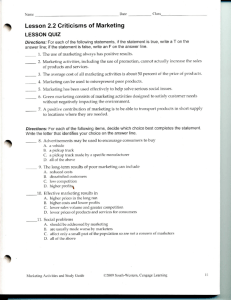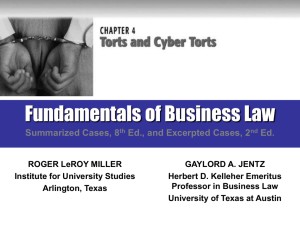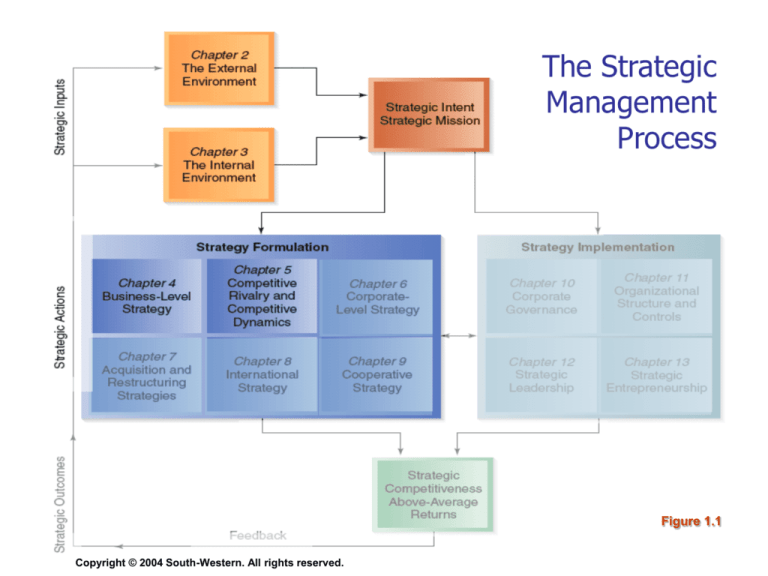
The Strategic
Management
Process
Figure 1.1
Copyright © 2004 South-Western. All rights reserved.
Copyright © 2004 South-Western. All rights reserved.
5–1
Chapter 5: Competitive Rivalry
• Competitive rivalry
• Multi-market (“multi-point”) competition
• Competitive dynamics
• Factors that increase the likelihood of
competitive response (or attack)
• First movers; second movers; late movers
• Strategic actions; tactical actions
• Fast cycle; slow cycle; standard cycle
markets
• Offensive moves; defensive moves
Copyright © 2004 South-Western. All rights reserved.
5–2
Effective Strategies . . . .
• address external trends
• pursue concrete opportunities
• acknowledge external threats
• rely on core capabilities
• do not rely on weaknesses
• are conscientiously implemented
• are continually fine-tuned
• outsmart rivals
Copyright © 2004 South-Western. All rights reserved.
5–3
Competitive Rivalry =
the ongoing set of competitive actions
and competitive responses
occurring between competitors.
One interesting result is that
competing firms are mutually interdependent,
especially when
“multi-market competition”
is present.
Copyright © 2004 South-Western. All rights reserved.
5–4
Multi-market Competition =
firms competing against each other in several
product areas, and/or
several geographic markets.
Multi-market competition creates
a more complex form of rivalry,
which can actually reduce aggressive
competitive attacks between the rivals.
Copyright © 2004 South-Western. All rights reserved.
5–5
From Competitors to Competitive Dynamics
SOURCE: Adapted from M.-J. Chen, 1996, Competitor analysis and interfirm rivalry:
Toward a theoretical integration, Academy of Management Review, 21: 100–134.
Copyright © 2004 South-Western. All rights reserved.
Figure 5.1
5–6
Competitive Dynamics . . .
• Actions taken by one firm elicit responses
from competitors.
• Competitive responses lead to additional
actions from the firm that acted originally.
• Actions and responses shape the
competitive positions of each firm’s
business-level strategy.
• Strategies are not fully pre-planned, but are
dynamic and evolving in response to
competition and other factors.
Copyright © 2004 South-Western. All rights reserved.
5–7
Success of a strategy is determined by:
The firm’s initial competitive actions
How well it anticipates competitors’ responses to
them
How well the firm anticipates and responds to its
competitors’ initial actions
Copyright © 2004 South-Western. All rights reserved.
5–8
A Model of Competitive Rivalry
SOURCE: Adapted from M.-J. Chen, 1996, Competitor
analysis and interfirm rivalry:Toward a theoretical integration,
Academy of Management Review, 21: 100–134.
Copyright © 2004 South-Western. All rights reserved.
Figure 5.2
5–9
Competitor Analysis (=
)
• Competitor analysis is used to help a firm
understand its competitors
• The firm studies competitors’ future
objectives, current strategies, assumptions,
and capabilities
• With the analysis, a firm is better able to
predict competitors’ behaviors when
forming its competitive actions and
responses
Copyright © 2004 South-Western. All rights reserved.
5–10
Market Commonality
• Market commonality is concerned with:
The number of markets with which a firm and a
competitor are jointly involved
The degree of importance of the individual
markets to each competitor
• Firms competing against one another in
several or many markets engage in
multimarket competition
A firm with greater multimarket contact is less
likely to initiate an attack, but more likely to more
respond aggressively when attacked
Copyright © 2004 South-Western. All rights reserved.
5–11
Resource Similarity
• Resource Similarity
How comparable the firm’s tangible and
intangible resources are to a competitor’s in
terms of both types and amounts
• Firms with similar types and amounts of
resources are likely to:
Have similar strengths and weaknesses
Use similar strategies
• Assessing resource similarity can be
difficult if critical resources are intangible
rather than tangible
Copyright © 2004 South-Western. All rights reserved.
5–12
A Framework of Competitor Analysis
Figure 5.3
Copyright © 2004 South-Western. All rights reserved.
5–13
Market Commonality
and Resource Similarity –
So what? Who cares?
Rivals with market commonality
and resource similarity are
highly likely to respond to the competitive
actions of each other.
Copyright © 2004 South-Western. All rights reserved.
5–14
A Model of Competitive Rivalry
SOURCE: Adapted from M.-J. Chen, 1996, Competitor
analysis and interfirm rivalry:Toward a theoretical integration,
Academy of Management Review, 21: 100–134.
Copyright © 2004 South-Western. All rights reserved.
Figure 5.2
5–15
Drivers of Competitive Behavior
Awareness
• Awareness is
the extent to which
organizations recognize
the degree of their
mutual interdependence
and the potential threat
from their competitive
rivalry
Copyright © 2004 South-Western. All rights reserved.
5–16
Drivers of Competitive Behavior (cont’d)
Awareness
Motivation
Copyright © 2004 South-Western. All rights reserved.
• Motivation
the intensity of a
firm’s inclination to
take action or to
respond to a
competitor’s attack
relates to perceived
gains and losses
may involve egos
5–17
Drivers of Competitive Behavior (cont’d)
Awareness
Motivation
Ability
• Ability relates to
each firm’s resources
the flexibility these
resources provide
• Without available
resources the firm
lacks the ability to
attack a competitor
respond to the
competitor’s actions
Copyright © 2004 South-Western. All rights reserved.
5–18
Drivers of Competitive Behavior (cont’d)
Awareness
• A firm is more likely to attack
the rival with whom it has
low market commonality
Motivation
Ability
Market
Commonality
Copyright © 2004 South-Western. All rights reserved.
• Given the high stakes of
competition under market
commonality, there is a high
probability that the attacked
firm will respond to its
competitor’s action in an
effort to protect its position
5–19
Drivers of Competitive Behavior (cont’d)
Awareness
Motivation
• The greater the resource
imbalance between the firms,
the greater will be the delay in
response by the firm with a
resource disadvantage
Ability
Market
Commonality
Resource
Dissimilarity
Copyright © 2004 South-Western. All rights reserved.
• When facing competitors with
greater resources or more
attractive market positions,
firms should eventually
respond, no matter how
challenging the response
5–20
Drivers of Competitive Behavior –
So what? Who cares?
Organizations are highly likely to respond to
competitive actions when the following
conditions are present:
• Market commonality
• Resource similarity
• Awareness of the competitive threat
• Motivation to respond
• High ego involvement in the rivalry
• Available resources to respond
Copyright © 2004 South-Western. All rights reserved.
5–21
A Model of Competitive Rivalry
SOURCE: Adapted from M.-J. Chen, 1996, Competitor
analysis and interfirm rivalry:Toward a theoretical integration,
Academy of Management Review, 21: 100–134.
Copyright © 2004 South-Western. All rights reserved.
Figure 5.2
5–22
Factors Affecting Likelihood of Attack
First Mover
•
First movers allocate
funds for:
Product innovation and
development, aggressive
advertising, advanced
research and development
• First mover incentives =
?
?
• First mover hazards =
?
?
Copyright © 2004 South-Western. All rights reserved.
5–23
Factors Affecting Likelihood of Attack (cont’d)
First Mover
Second Mover
Copyright © 2004 South-Western. All rights reserved.
• Second mover responds to the
first mover’s competitive action,
typically through imitation:
Studies customers’ reactions to
product innovations
Tries to find and avoid any
mistakes the first mover made
Also avoids the huge
product/market development
spending of the first-movers
May develop more efficient
processes and technologies
5–24
Factors Affecting Likelihood of Attack (cont’d)
First Mover
Second Mover
Late Mover
Copyright © 2004 South-Western. All rights reserved.
• Late mover responds to a
competitive action only after
considerable time has elapsed
• Any success achieved will be
slow in coming and much less
than that achieved by first and
second movers
• Late mover’s competitive action
allows it to earn only average
returns and delays its
understanding of how to create
value for customers
5–25
Factors Affecting Likelihood of Attack (cont’d)
First Mover
Second Mover
• Small firms are more likely:
To launch offensive competitive
actions
To be quicker in doing so
• Small firms are perceived as:
Late Mover
Nimble and flexible competitors
Organizational
Size
Having the flexibility needed to
launch a greater variety of
competitive actions
Copyright © 2004 South-Western. All rights reserved.
Relying on speed and surprise
5–26
Factors Affecting Likelihood of Attack (cont’d)
First Mover
Second Mover
Late Mover
Organizational
Size
• Large organizations
commonly have the slack
resources required to
launch a larger number of
total competitive actions
• “Think and act big and
we’ll get smaller. Think and
act small and we’ll get
bigger.”
Herb Kelleher
Former CEO, Southwest
Airlines
Copyright © 2004 South-Western. All rights reserved.
5–27
Factors Affecting Likelihood of Attack (cont’d)
First Mover
Second Mover
Late Mover
Organizational
Size
Quality
(Product)
Copyright © 2004 South-Western. All rights reserved.
• Firms with higher quality
are more likely to attack
• Product quality can
involve performance,
features, durability,
consistency,image, etc.
• Service quality can
involve timeliness,
courtesy, convenience,
accuracy, completeness,
etc.
5–28
Summary – Factors that Increase the
Likelihood of Competitive Attack
• first mover incentives
• active first movers
• small firms
• firms with high “quality”
Copyright © 2004 South-Western. All rights reserved.
5–29
A Model of Competitive Rivalry
SOURCE: Adapted from M.-J. Chen, 1996, Competitor
analysis and interfirm rivalry:Toward a theoretical integration,
Academy of Management Review, 21: 100–134.
Copyright © 2004 South-Western. All rights reserved.
Figure 5.2
5–30
Strategic and Tactical Actions
• Strategic action or a strategic response =
• Tactical action or a tactical response =
Copyright © 2004 South-Western. All rights reserved.
5–31
Likelihood of Response
Type of
Competitive
Action
• Strategic actions generally
require strategic responses
The time and resources needed
to assess and implement a
strategic action delays or even
reduces potential response
• Tactical responses are taken
to counter the effects of
tactical actions
Competitor likely will respond
quickly to a tactical actions
Copyright © 2004 South-Western. All rights reserved.
5–32
Factors Affecting Strategic Response (cont’d)
Type of
Competitive
Action
Actor’s
Reputation
• An actor is the firm taking an
action or response
• Reputable firms are more
likely to elicit a response
• Market leaders are more
likely to be copied
• Firms that are not well
regarded, or price-predators,
are less likely to be copied or
elicit a response
Copyright © 2004 South-Western. All rights reserved.
5–33
Factors Affecting Strategic Response (cont’d)
Type of
Competitive
Action
Actor’s
Reputation
Dependence
on the market
Copyright © 2004 South-Western. All rights reserved.
• Market dependence is the
extent to which a firm’s
revenues or profits are
derived from a particular
market
• In general, firms can predict
that competitors with high
market dependence are likely
to respond strongly to
attacks threatening their
market position
5–34
Summary – Factors that Increase the
Likelihood of Competitive Response
• Actions that are tactical rather than strategic
• The organization initiating the original
competitive action is reputable
• High dependency on the market involved
Copyright © 2004 South-Western. All rights reserved.
5–35
A Model of Competitive Rivalry
SOURCE: Adapted from M.-J. Chen, 1996, Competitor
analysis and interfirm rivalry:Toward a theoretical integration,
Academy of Management Review, 21: 100–134.
Copyright © 2004 South-Western. All rights reserved.
Figure 5.2
5–36
Competitive Dynamics
Slow-Cycle
Markets
• Competitive advantages are
shielded from imitation for
long periods of time and
imitation is costly
• Competitive advantages are
sustainable in slow-cycle
markets
• Firms concentrate on
competitive actions and
responses to protect, maintain
and extend proprietary
competitive advantage
Copyright © 2004 South-Western. All rights reserved.
5–37
Gradual Erosion of a Sustained Competitive Advantage
SOURCE: Adapted from I. C. MacMillan, 1988, Controlling competitive dynamics
by taking strategic initiative, Academy of Management Executive, 11(2): 111–118.
Copyright © 2004 South-Western. All rights reserved.
Figure 5.4
5–38
Competitive Dynamics (cont’d)
Slow-Cycle
Markets
Fast-Cycle
Markets
“Hypercompetition”
• The firm’s competitive
advantages are not sustainable
• Non-proprietary technology is
diffused rapidly, reverse
engineering is used to
duplicate proprietary
technology
• Competitive “oneupsmanship” is rampant
• Firms may need to practice
product cannibalism in selfdefense
Copyright © 2004 South-Western. All rights reserved.
5–39
Obtaining Temporary Advantages to Create
Sustained Advantage
SOURCE: Adapted from I. C. MacMillan, 1988, Controlling competitive dynamics
by taking strategic initiative, Academy of Management Executive, 11(2): 111–118.
Copyright © 2004 South-Western. All rights reserved.
Figure 5.5
5–40
Competitive Dynamics (cont’d)
Slow-Cycle
Markets
• Moderate cost of imitation may
shield competitive advantages.
Fast-Cycle
Markets
• Competitive advantages are
partially sustainable if their
quality is continuously
upgraded
Standard-Cycle
Markets
• Firms
Seek large market shares
Gain customer loyalty through
brand names
Carefully control operations
Copyright © 2004 South-Western. All rights reserved.
5–41
Competitive Rivalry = continuous “play” of
offensive and defensive moves
Offensive Moves
• To establish a position
• To reposition
Defensive Moves
• To protect an existing
position
• Less frequent than defensive
moves
• Attacking rivals’ weaknesses
is usually more successful
• Attacking rival’s strengths –
especially head-on – carries
more risk and takes more
resources and capabilities
Common approaches =
• Increase structural barriers
(fill positioning gaps,
increase switching costs,
increase scale economies,
block supplies or channel . .)
• Increase expected retaliation
• Lower inducements for
attack
Copyright © 2004 South-Western. All rights reserved.
5–42

